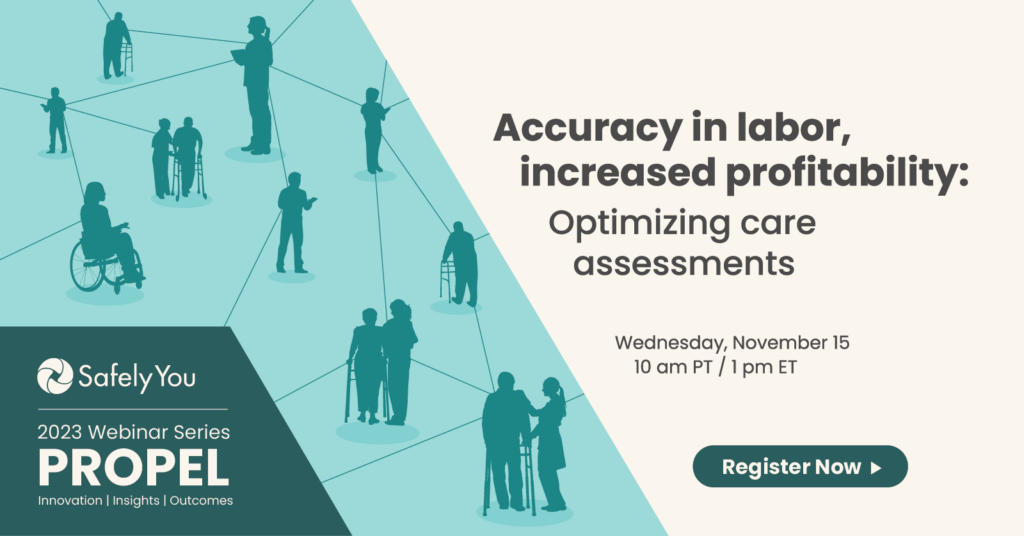Two out of three prospective residents and families ask about fall mitigation strategies when considering a new community.
SafelyYou launches inaugural State of Falls report and quantifies the average direct cost of falls annually for those communities: $380,000.
SAN FRANCISCO–(BUSINESS WIRE)–In recognition of Falls Prevention Awareness Week (Sept. 18-24), SafelyYou, the leader in empowering safer, more person-centered dementia care through real-time AI video technology and 24/7 remote clinical experts, today launched its inaugural 2022 State of Falls report with research findings that bring into clear focus how prevalent, serious, and costly falls are across the country’s senior living communities.
“Our State of Falls report highlights the significant impact falls have across senior care, capturing the enormous emotional, physical, and financial tolls they take”
Key findings:
- Eighty-five percent (85%) of senior care executives report that falls significantly impact staff turnover;
- Nearly half (46%) of senior care staff report that labor is a top challenge; 66% say labor issues lead to a decreased quality of care;
- For enterprise senior care providers, residents experience an average of 378 falls per year; at skilled nursing facilities (SNFs), the annual average is 278;
- Nearly one-quarter (24%) of falls among residents resulted in moving the individual to an increased level of care;
- One out of five community staff say there are more falls since mid-2020/pre-COVID.
“Our State of Falls report highlights the significant impact falls have across senior care, capturing the enormous emotional, physical, and financial tolls they take,” said George Netscher, founder and CEO of SafelyYou. “What we have discovered is that in the midst of this crisis, there’s great opportunity for change—and senior care providers are ready for it. The majority plan to elevate their fall prevention strategies within the next year, implementing innovation and staff training to reduce falls in their communities. At SafelyYou, our clinical team has reviewed more than 50,000 on-the-ground events—so we know more about falls than anyone else in the world—and we remain committed to creating a future where falls are fewer and senior living communities are safer.”
The link between falls and staffing challenges
With nearly half of respondents (46%) reporting that labor—recruitment, retention and churn—is a top challenge, the State of Falls report measures the impact staffing has on falls.
- Sixty-six percent (66%) say those labor issues lead to decreased quality of care;
- Two in three recognize that inadequate staffing has a significant impact on fall-related incidents;
- Eighty-five percent (85%) of facility executives report that falls significantly impact staff turnover.
The report also reveals how much time clinical staff spends on fall-related issues: on average, about one full work day each week (17% of their time).
The cost of falls
Across assisted living communities and skilled nursing facilities, the annual direct cost of all falls is $380,000. For enterprise communities, the average is $712,000; for SMBs, it is $158,000.
When a resident experiences a fall, the financial impact can be felt across the organization.
- Skilled nursing facilities lose an average of $250 per day when a resident moves out for any length of time;
- The average length a resident moves out temporarily is 21 days;
- When a resident leaves an assisted living community temporarily, the majority – 60% – refund or credit care costs, while 41% provide a rent refund or credit.
Beyond direct costs, six in 10 facility executives believe that improving their ability to reduce falls would be highly effective to increase their competitive advantage.
The true impact of falls
On average, assisted living communities and skilled nursing facilities report an average of 260 resident falls across the organization per year; two out of ten executives and care providers say there are more falls at their communities today than before COVID hit in 2020.
The fall-out:
- Twenty-four percent (24%) of falls resulted in moving residents to increased level care;
- 1 in 7 move-outs were related to falls;
- Fifty-nine percent (59%) report that falls impact the ability to provide a high level of resident care.
What is and can be done to prevent falls
The findings reveal a reason for hope: one half of respondents believe falls can be prevented, with many actively taking steps to do so.
- Sixty-six percent (66%) have a fall safety team in place to focus on fall prevention and training;
- 8 in 10 train staff in fall safety;
- Nearly all senior care providers – 93% – believe that the right technology can significantly help prevent falls.
“Falls are often seen as an inevitable part of the aging process, but so much can be done to help prevent them,” said Glen Xiong, M.D., clinical professor at UC Davis Health and chief medical officer at SafelyYou. “The more we can do to make our care providers aware of fall risks, highlight best practices for preventing falls, and implement innovative new solutions, the better quality of care our senior living communities will be able to provide—and the better off our seniors will be.”
Access the full report: https://www.safely-you.com/cost-of-falls-report/
Survey Methodology
SafelyYou commissioned Merrill Research to conduct quantitative and qualitative research of 210 executives and 200 care champions at care facilities across the U.S. The research was conducted in April/May 2022.
SafelyYou conducted an online survey in July 2022 to measure and quantify Americans’ sentiments around falls and aging. The survey captured responses from a broad distribution of 1,249 Adults (42+) in the U.S.






